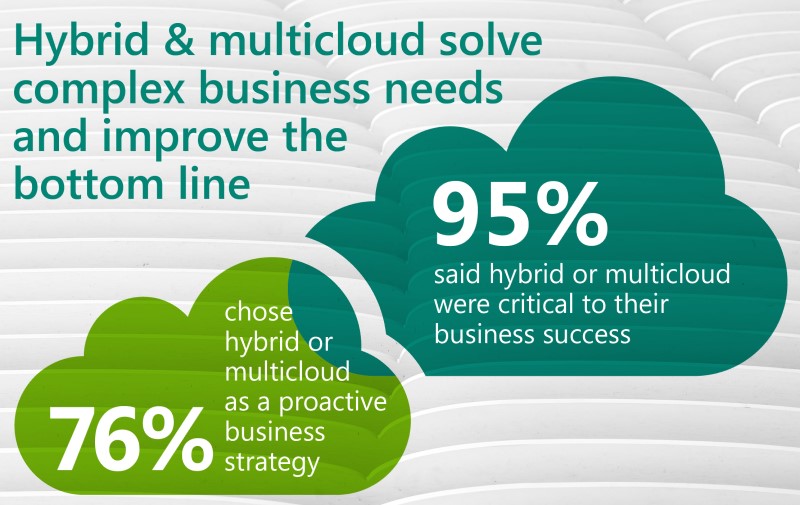For many of the world’s largest organizations, mainframe platforms continue to serve as the strategic foundation for their most trusted and critical business services. Meanwhile, the growth of cloud has opened a digital divide between the traditional core and the fast-moving new; with hybrid cloud seen as the key to unlocking the full potential of both.
A recent Microsoft-sponsored study revealed that 95% of respondents considered hybrid and multi-cloud technologies critical to their business success, and this hybrid approach is a key tenet of Microsoft's cloud strategy.
As hybrid cloud architectures mature, bringing together mainframe and cloud platforms, Microsoft provides multiple ways to extend and accelerate mainframe applications and data services in situ.
- Accelerating Application Delivery applies DevOps tooling, practices, and culture to mainframe services to provide a seamless app/dev experience throughout the enterprise.
- Simplifying Application Integration enables cloud-native apps to quickly and securely access mainframe-hosted business logic, with no prior knowledge of the underlying service.
- Data Analytics & Insight derives new meaning from core data, through enriched data analysis in cloud, event streams, or visualization and analysis on live mainframe data.
- Optimizing Infrastructure - Back-Up & Archive exploits the global reach of cloud storage to simplify the infrastructure and costs associated with creating fail-safe data for recovery.

Accelerating Application Delivery
Historically, mainframe application delivery employed waterfall practices, with green screen development tools and library management-based source code repositories. Development team productivity was further hampered by platform constraints, when production demanded maximum capacity. Many of these challenges still persist today, requiring exotic skillsets, resulting in inefficient and slow release cycles.
There are several ways that Microsoft helps to address these challenges today.
- Dev & test z/OS environments in Azure provides Dev teams unconstrained access to fully supported IBM z/OS runtimes to build and test the functional aspects of their services, whilst freeing mainframe capacity for production. Dev teams can spin-up and tear-down z/OS guests in Azure, with technologies such as PopUp Mainframe, to fully exploit the powerful automation, self-service provisioning, and versioned-controlled building blocks of cloud infrastructure.
- Contemporary development tooling vastly improves the developer experience and productivity, with widely-adopted technologies such as Visual Studio and GitHub Enterprise, enabling new developers to build and collaborate on mainframe applications from Day 1. Looking ahead, Microsoft is enabling citizen developers to create powerful new ‘low-code/ no-code’ apps against a mainframe backdrop, with technologies such as Power Apps addressing latent skills challenges.
- A comprehensive DevOps experience transcends platform and runtime environments, to seamlessly deliver new services at speed. Technologies such as IBM Dependency Based Build and Broadcom Endevor Bridge for Git provide a natural mainframe extension to the enterprise-wide delivery capabilities of Azure DevOps.
Simplifying Application Integration
There is a vast array of options to connect to the business logic encapsulated in mainframe applications and services, ranging from bespoke network-based adapters, custom technology connectors to file, message, or web service-based solutions. While these are viable integration options, they burden the cloud-native developer with knowledge of the underlying implementation. For instance, a typical mainframe interface requires the developer to construct requests in highly complex COBOL copybook structures, with all the relevant fields, flags, REDEFINE statements and so on.
In recent years, new solutions have become available which enable cloud-native developers to build apps that securely consume mainframe business logic, with no change required to the underlying service. Technologies such as Azure Logic Apps, provide cloud-based automation and integration workflows that provide secure service façades to existing message and green screen-based interfaces. In contrast, native mainframe REST APIs can now be used to discover, build, and consume simplified, industry standard OpenAPI 3 interfaces with technologies such as IBM z/OS Connect.
These integration technologies now provide cloud-native and citizen developers with vastly simplified, yet highly secured access to mainframe business logic.
Data Analytics & Insight
The ability for organizations to extract insight from business data provides a key competitive advantage, and yet data often exists in silos that is application or platform specific. This is especially true of mainframe, that is often rich in data and stored in esoteric repositories. The resulting silos inhibit the data sharing necessary for timely data-driven decision making.
There are multiple ways Microsoft can help derive new insights from mainframe data, including:
- Copying mainframe data to Azure, using traditional ETL or ELT techniques. Relying on technologies such as Azure Data Factory, the data can be augmented and enriched and delivered to data repositories, such Azure Data Lake or integrated analytics platforms, such as Azure Synapse Analytics for later analysis.
- Event-driven architectures that deliver updates in real-time to downstream target systems. This exploits event streaming technologies, such as Qlik Software, along with Azure Event Hubs to correlate and disseminate the information to registered subscribers.
- Data visualization and reporting provides a powerful way to view, navigate and interrogate mainframe data in place, observing trends and analysis in real-time with Power BI.
Optimising Infrastructure: Back-up & Archive
Creating a fail-safe recovery for the business critical data that resides on mainframes is essential, but this strategy has remained largely unchanged since its inception. Common practice is to provide multiple, redundant back-up options on disk and tape, replicated across two or more physical locations, resulting in a highly complex infrastructure to manage, and a lengthy back-up process during which mainframe capacity is diverted away from production workloads.
Today, organizations are exploiting the global reach of Azure object storage to reduce back-up and archiving cost whilst optimising infrastructure, performance, and resilience. Solutions such as Model9, have a proven track record in improving mainframe resilience through additional back-up copies in any region globally in Azure. Alternatively, back-up infrastructure can be replaced entirely, massively simplifying environments and reducing back-up times from several hours to a matter of minutes.
Mainframe Extend Pattern: The Key to Unlocking a Successful Hybrid Cloud

As organizations embrace their own unique cloud journeys, the mix of on-premises services with cloud is incredibly powerful. The Extend Patterns summarised here are just a few examples of Microsoft’s experiences in combining mainframe with cloud – and is by no means an exhaustive list.
Regardless of whether these patterns are implemented to incorporate mainframe platforms into hybrid cloud, or simply to optimize cost as part of a sunset strategy, they should be considered a key part of any cloud journey.
If you would like to learn more about our approach, please contact us at: mainframetransformed@microsoft.com.

